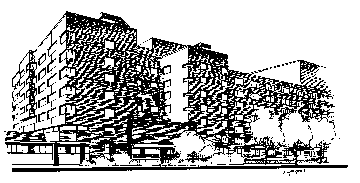On January 27, 1881, the Methodist Episcopal newspaper, The Christian Advocate, printed a piece by its influential editor, James Monroe Buckley. Buckley had been a church pastor in Connecticut just before his election as editor. The editorial related the unhappy story of the organist at Buckley’s former charge. The organist, visiting New York City, was struck by a panicked team of horses and died because there was no adequate hospital care available.
This tragedy spurred Buckley to call for the establishment of a hospital, the first in Methodism. As Buckley wrote, “it is about time the Methodist Episcopal church erected a hospital somewhere in this world.”
George I. Seney, son of a Methodist minister, read Buckley’s editorial challenge and responded by giving property and cash to launch the hospital in 1881 as a memorial to his father. The hospital was chartered on May 27, 1881. Plans called for nine buildings, and construction on the first three began immediately.
The idea did meet with some criticism from those who believed that the denomination should focus on building churches and preaching the Gospel. However, the late nineteenth century was an era when churches were increasingly involved in social outreach, and support for the hospital came from many quarters.
That support was especially welcome when George Seney suffered financial reversals and other backers were needed. The partially completed buildings were boarded up for several years while the money was raised. Construction began again in the spring of 1887. The first buildings were dedicated on December 15, and the first patient was admitted four days later.
A Training School for Nurses opened in 1888; a children’s ward and an outpatient department opened in 1889. Other departments – surgery, obstetrics, a nurses’ residents – opened over the next few years, with construction financed by churches, women’s groups, and individuals. In 1931, its golden anniversary year, the hospital became a teaching hospital, adding another dimension to its work.
In January 2017, New York Methodist Hospital became part of the NewYork-Presbyterian Regional Hospital network and the name was changed to NewYork-Presbyterian Brooklyn Methodist Hospital.
Today, Methodist Hospital is one of the leading medical facilities in the city of New York, and one of over seventy United Methodist hospitals in the continental United States.
Points of interest at this Heritage Landmark: No part of the original structure remains, but visitors may tour the present-day facilities which are still closely tied to The United Methodist Church. A plaque commemorates the hospital’s status as an Heritage Landmark. A bust of James Monroe Buckley is displayed, and other artifacts and photographs of the hospital’s early history may be viewed. The hospital has a permanent historical exhibit displayed in the atrium of the Carrington Pavilion.
Special events: None as of this writing.
Area attractions: The Brooklyn Museum, Brooklyn Botanical Gardens, Prospect Park, and Brooklyn Bridge are all nearby. The hospital is close to lower Manhattan, home to South Street Seaport, Chinatown, the Battery, and John Street United Methodist Church UM Heritage Landmark.
To visit: To arrange for a guided tour, contact the Department of Public Relations (see address below). For a “virtual history tour,” visit the hospital’s website.
Location: Within the boundaries of the New York Annual Conference, in Kings County. The hospital is at 506 Sixth Street in Brooklyn.
Food and lodging: The hospital cafeteria is open from 7:00 a.m. to 7:00 p.m. daily.
Directions: From the Northwest: Access the Prospect Parkway from the Holland Tunnel, Lincoln Tunnel, Saw Mill Parkway, or Tappan Zee Bridge. Exit the Prospect Parkway at the Tenth Avenue exit, then turn back to Eighth Avenue. Turn right on Eighth Avenue and left on Sixth Street. There is a public parking garage on Sixth Street, just short of Seventh Avenue.
From the George Washington Bridge: Follow the Harlem River and FDR Drive to the Brooklyn Bridge, then Flatbush Avenue to Prospect Park West Avenue. Turn right on Sixth Street and turn right again. There is a public parking garage on Sixth Street, just short of Seventh Avenue.
From the West: Take the Goethals Bridge across the Verrazano Bridge. Stay on the expressway to the 38th Street exit. Turn left on Fifth Avenue and drive to Seventh Street; turn right again to Eighth Avenue. At Eighth Avenue, turn left for one block, then turn left again at Sixth Street. There is a public parking garage on Sixth Street, just short of Seventh Avenue.
For further information, contact: Department of Public Relations, New York-Presbyterian Brooklyn Methodist Hospital, 506 Sixth St., Brooklyn, NY 11215; 718-780-5367.
To learn more about United Methodist church history in this area:
Tim Riss, Archivist: C. Wesley Christman Archives, New York Annual Conference Center, 20 Soundview Avenue, White Plains, NY 10606; 914-615-2241; E-Mail: Timothy.Riss@nyac-umc.com.
David C. Crummey, Factors in the Rise of Methodist Hospitals and Homes (Ph.D dissertation, University of Chicago, 1963).
George Preston Mains, James Monroe Buckley (New York: Methodist Book Concern, 1917).

